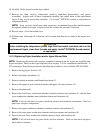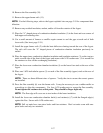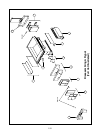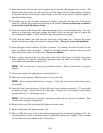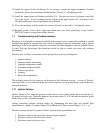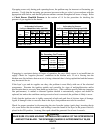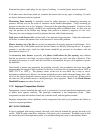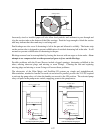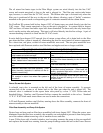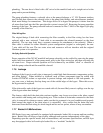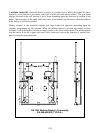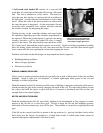1-24
Examine the ignitor (spark plug) for any signs of cracking. A cracked ignitor must be replaced.
If all other causes have been ruled out, examine the burner tiles for any signs of cracking. If cracks
are found, the burner must be replaced.
Fluctuating flame intensity is normally caused by either improper or fluctuating incoming gas
pressure, but may also be the result of variations in the kitchen atmosphere. Verify incoming gas
pressure in the same way as for “popping,” discussed in the preceding paragraphs. Variations in the
kitchen atmosphere are usually caused by air conditioning and/or ventilation units. As they start and
stop, the pressure in the kitchen may change from positive or neutral to negative, or vice versa.
They may also cause changes in airflow patterns that may affect flame intensity.
Dark spots on the burner tiles are the result of an improper air/gas mixture. Adjust the combustion
air blower to reduce the amount of air in the mixture to correct this problem.
Flames shooting out of the flue are usually an indication of negative pressure in the kitchen. Air is
being sucked out of the burner enclosure and the flames are literally following the air. If negative
pressure is not the cause, check for high burner manifold gas pressure in accordance with the
procedure in Section 1.4.
An excessively noisy burner, especially with flames visible above the flue opening, may indicate
that the gas pressure is too high, or it may simply be that the gas valve vent tube is blocked. If the
incoming gas pressure is correct and the vent tube is unobstructed, the gas valve regulator is proba-
bly defective.
Occasionally a burner may apparently be operating correctly, but nevertheless the fryer has a slow
recovery rate (the length of time required for the fryer to increase the oil temperature from 250ºF to
300ºF (121ºC to 149ºC)). The primary causes of this are an over-filled vat, a dirty or out-of-
adjustment combustion air blower, low burner manifold pressure, and/or damaged burner tiles. Add-
ing oil to the frypot during the recovery process will also cause a slow recovery rate. If these causes
are ruled out, the probable cause is a misadjusted gas valve regulator. Refer to the Check Burner
Manifold Pressure procedure Section 1.4.
1.7.3 Improper Temperature Control
Temperature control, including the melt cycle, is a function of several interrelated components, each
of which must operate correctly. The principle component is the temperature probe. Other
components include the interface board, the controller itself, and the ignition module.
Improper temperature control problems can be categorized into melt cycle problems and failure to
control at setpoint problems.
MELT CYCLE PROBLEMS
In fryers equipped with analog controls, the melt cycle must be initiated by pressing the melt cycle
switch. With all other controllers, initiation of the melt cycle is automatic. Problems may be with
the controller itself, the temperature probe, or a malfunctioning heat relay on the interface board.



